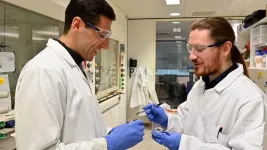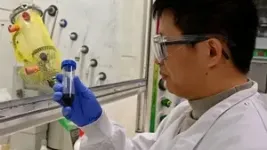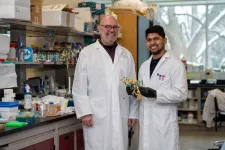(Press-News.org) UNDER EMBARGO UNTIL: 16:00 GMT / 12 NOON ET WEDNESDAY 26 MARCH 2025
A new method to recycle fluoride from long-lived PFAS chemicals
Images available via the link in the notes section.
Oxford Chemistry researchers have developed a method to destroy fluorine-containing PFAS (sometimes labelled ‘forever chemicals’) while recovering their fluorine content for future use. The results have been published today (26 March 2025) in Nature.
PFAS – which stands for poly- and perfluoroalkylated substances – have been produced in large quantities for over 70 years. They are found in a wide variety of products including textiles, food packaging, non-stick cookware, and medical devices. Their unique properties come from multiple carbon-fluorine chemical bonds, a particularly strong chemical motif that also explains their resistance to degradation.
This longevity has led to PFAS sometimes being referred to as “forever chemicals”. Their persistence has resulted in widespread contamination around the world. Traces of PFAS have been found in drinking water and livestock, and have been associated with negative human health effects after chronic exposure.
This global problem urgently needs innovative technologies for the detection, recovery, and destruction of PFAS, as well as responsible pipelines to manage PFAS waste.
Now, a team of chemists at the University of Oxford and Colorado State University have shown it is possible to destroy a wide variety of these fluorine-containing PFAS chemicals while also recovering their fluorine content for reuse in industrial processes.
This operationally straightforward method works by reacting PFAS samples with potassium phosphate salts in the solid state. The reactants are ground together with ball bearings, which breaks down the long-lasting PFAS chemicals and allows the researchers to extract the fluorine content from the resulting product. In the study, the recovered fluoride was then used to generate common fluorinating reagents, which worked effectively in industrial reactions.
This recovery of fluoride, for re-entry into the fluorochemical industry, goes towards enabling a circular fluorine economy. This is particularly important given that fluorspar, the mineral from which essentially all fluorochemicals are manufactured, is categorised as critical for many industrial processes by nations around the world. Furthermore, the phosphate used as an activator in the PFAS destruction process was recovered and reused, implying no detrimental impact on the phosphorus cycle.
The team’s method enables the mechanical destruction of all PFAS classes, including those commonly found in products such as non-stick coatings, electrical insulation, and industrial tubing. This means that the fluorine content from everyday waste such as Teflon tape could be recovered and used to generate important fluorine-containing chemicals, including precursors to pharmaceutical and agrochemicals such as cholesterol-lowering statin medications (Lipitor), anti-seizure agents (Rufinamide), and herbicides (Triaziflam).
A serendipitous observation made in the course of a previous study served as a starting point for the team’s investigation. In an earlier set of experiments using a similar ball-milling method, they noticed that the PFAS-containing sealing rings of the ball-milling jars were degraded during the reaction, resulting in higher fluoride yields than expected. They concluded that their process must be breaking down the PFAS in these sealing rings and liberating fluoride. They wondered if the method may be able to break down and upcycle other examples of PFAS, and have now demonstrated that the method does indeed have broad applicability across a wide range of PFAS.
Professor Véronique Gouverneur (University of Oxford), who led the study, said:
“Fluoride recovery is important because our reserves of Fluorspar, essential for the manufacturing of e.g. life-saving medicines, are rapidly depleting due to extensive mining. This method not only eliminates PFAS waste but also contributes to a circular fluorine chemistry by transforming persistent pollutants into valuable fluorochemicals.”
Dr Long Yang (University of Oxford), one of the lead authors of the study, said:
“The mechanochemical destruction of PFAS with phosphate salts is an exciting innovation, offering a simple yet powerful solution to a long-standing environmental challenge. With this effective PFAS destruction method, we hope to shift away from the notion of PFAS as ‘forever chemicals’.”
Work at Colorado State University was led by Marshall Fixman and Branka Ladanyi Professor Robert Paton as part of the Department of Chemistry in the College of Natural Sciences.
Notes for editors:
For any further enquiries please contact: Long Yang (long.yang@chem.ox.ac.uk), Thomas Schlatzer (thomas.schlatzer@chem.ox.ac.uk), Christopher Goult (christopher.goult@chem.ox.ac.uk), or Zijun Chen (zijun.chen@chem.ox.ac.uk).
Images related to this study for use in articles are available at https://drive.google.com/drive/folders/1HTjyB_ji9ASdXgSoCQjKCLqjwotCMAjP?usp=sharing
These are for editorial purposes relating to this press release ONLY and MUST be credited (see file name). They MUST NOT be sold on to third parties.
The study ‘Phosphate–Enabled Mechanochemical PFAS Destruction for Fluoride Reuse’ will be published in Nature at 16:00 GMT / 12 noon ET Wednesday 26 March 2025 doi.org/10.1038/s41586-025-08698-5 To view a copy of the paper before this under embargo, contact one of the researchers above.
About the University of Oxford
Oxford University has been placed number 1 in the Times Higher Education World University Rankings for the ninth year running, and number 3 in the QS World Rankings 2024. At the heart of this success are the twin-pillars of our ground-breaking research and innovation and our distinctive educational offer.
Oxford is world-famous for research and teaching excellence and home to some of the most talented people from across the globe. Our work helps the lives of millions, solving real-world problems through a huge network of partnerships and collaborations. The breadth and interdisciplinary nature of our research alongside our personalised approach to teaching sparks imaginative and inventive insights and solutions.
Through its research commercialisation arm, Oxford University Innovation, Oxford is the highest university patent filer in the UK and is ranked first in the UK for university spinouts, having created more than 300 new companies since 1988. Over a third of these companies have been created in the past five years. The university is a catalyst for prosperity in Oxfordshire and the United Kingdom, contributing £15.7 billion to the UK economy in 2018/19, and supports more than 28,000 full time jobs.
About Colorado State University
Colorado State University, one of the nation’s top-performing public research institutions, has more than 33,000 students. Founded in 1870 as Colorado’s land-grant institution, CSU is renowned for its world-class faculty and research and academic programs in infectious disease, atmospheric science, clean energy technologies, human and animal health, environmental science, global business and more. CSU graduates on average carry less student debt and are employed at higher rates than their peers nationwide.
CSU’s College of Natural Sciences studies foundational science – asking fundamental questions and applying knowledge to every field of study. With eight departments and 10 centers, the College is a leader in research, teaching and community engagement, supporting more than 4,500 undergraduates and 700 master’s and Ph.D. candidates.
More information on Professor Paton: https://newsmediarelations.colostate.edu/contacts/robert-paton/
END
A new method to recycle fluoride from long-lived PFAS chemicals
2025-03-26
ELSE PRESS RELEASES FROM THIS DATE:
A breakthrough moment: McMaster researchers discover new class of antibiotics
2025-03-26
The last time a new class of antibiotics reached the market was nearly three decades ago — but that could soon change, thanks to a discovery by researchers at McMaster University.
A team led by renowned researcher Gerry Wright has identified a strong candidate to challenge even some of the most drug-resistant bacteria on the planet: a new molecule called lariocidin. The findings were published in the journal Nature on March 26, 2025.
The discovery of the all-new class of antibiotics responds to a critical need for new antimicrobial ...
The devastating human impact on biodiversity
2025-03-26
Humans are having a highly detrimental impact on biodiversity worldwide. Not only is the number of species declining, but the composition of species communities is also changing. These are the findings of a study by Eawag and the University of Zurich published in the scientific journal Nature. It is one of the largest studies ever conducted on this topic.
Biological diversity is under threat. More and more plant and animal species are disappearing worldwide, and humans are responsible. Until now, however, there has been no synthesis of the extent of human intervention in nature and whether the effects can be found everywhere in the world ...
Calorie-free sweeteners can disrupt the brain’s appetite signals
2025-03-26
Compared to sugar, consuming sucralose—a widely used sugar substitute—increases activity in the hypothalamus, a brain region that regulates appetite and body weight, according to a new USC study. Sucralose also changes how the hypothalamus communicates with other brain regions, including those involved in motivation. The study was just published in the journal Nature Metabolism.
About 40% of Americans regularly consume sugar substitutes, usually as a way to reduce calories or sugar intake. “But are these substances actually helpful for regulating ...
Researchers achieve quantum computing milestone, realizing certified randomness
2025-03-26
In a new paper in Nature, a team of researchers from JPMorganChase, Quantinuum, Argonne National Laboratory, Oak Ridge National Laboratory and The University of Texas at Austin describe a milestone in the field of quantum computing, with potential applications in cryptography, fairness and privacy.
Using a 56-qubit quantum computer, they have for the first time experimentally demonstrated certified randomness, a way of generating random numbers from a quantum computer and then using a classical supercomputer to prove they are truly random and freshly generated. This could pave the way towards the use of quantum computers for a practical task unattainable through ...
Lasso-shaped antibiotic co-developed by UIC evades standard drug resistance
2025-03-26
A small molecule shaped like a lasso may be a powerful tool in the fight against infectious diseases, according to a new study in Nature co-authored by University of Illinois Chicago researchers.
Lariocidin, a peptide made by bacteria living in soil, was effective against several different microbes responsible for deadly infections. UIC researchers working with collaborators at McMaster University in Canada determined how the new antibiotic works and why the drug evades bacterial resistance.
“The holy grail in the field is to find an antibiotic that binds to a new site target, has a novel mechanism of action and has ...
Two studies explore impact of pandemic on colorectal cancer screening and diagnosis
2025-03-26
INDIANAPOLIS – Two recent studies by researchers from Regenstrief Institute and the Indiana University School of Medicine explore the effect of the pandemic on colorectal cancer screening tests and diagnostic colonoscopies in Central Indiana. The findings of temporary disruption to the former and minimal impact on the latter are similar to findings across the U.S., contributing to the compendium of knowledge on preventive health uptake and subsequent treatment in various populations during the pandemic.
One study, published in PLoS One, examines both non-invasive and colonoscopy screening trends during the pandemic. The other study, ...
“Osteo-cardiovascular” patients at highest risk for falls and death, Chinese study finds
2025-03-26
A new study by researchers at Peking University and the Chinese PLA General Hospital has found that multimorbidity—living with multiple chronic diseases—is closely associated with worsening fall conditions and mortality among middle-aged and older adults in China. The findings, published in Health Data Science, identify a distinct group at especially high risk: individuals with both cardiovascular and musculoskeletal conditions, dubbed the “osteo-cardiovascular fallers.”
Falls are a major cause of injury and death in older populations globally, particularly ...
AI analysis of healthcare records reveals key factors in autism diagnosis
2025-03-26
Without clear and effective biological tests for autism based on genes, brain or blood measurements, diagnosis today still largely depends on clinical assessment. The standard way of doing this is by observing how the individual fits the criteria for autism listed in gold standard manuals like the Diagnostic and Statistical Manual of Mental Disorders, Fifth Edition (DSM-5).
These criteria are divided into two categories: one for restricted or repetitive behaviours, actions, or activities, and another for differences in social communication and interaction. In the end, however, it is the clinician, relying on years of ...
Repetitive behaviors and special interests are more indicative of an autism diagnosis than a lack of social skills
2025-03-26
People with autism are typically diagnosed by clinical observation and assessment. To deconstruct the clinical decision process, which is often subjective and difficult to describe, researchers used a large language model (LLM) to synthesize the behaviors and observations that are most indicative of an autism diagnosis. Their results, publishing in the Cell Press journal Cell, show that repetitive behaviors, special interests, and perception-based behaviors are most associated with an autism diagnosis. These findings have potential to improve diagnostic guidelines ...
Long-term risk of stroke after transient ischemic attack or minor stroke.
2025-03-26
About The Study: Patients who have had a transient ischemic attack (TIA) or minor stroke are at a persistently high risk of subsequent stroke. The findings from this study underscore the need for improving long-term stroke prevention measures in this patient group.
Corresponding Author: To contact the corresponding author, Faizan Khan, PhD, email faizan.khan1@ucalgary.ca.
To access the embargoed study: Visit our For The Media website at this link https://media.jamanetwork.com/
(doi:10.1001/jama.2025.2033)
Editor’s Note: Please see the article for additional information, including other authors, author contributions ...





